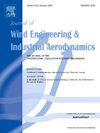Time-domain state-space model formulation of motion-induced aerodynamic forces on bridge decks
IF 4.2
2区 工程技术
Q1 ENGINEERING, CIVIL
Journal of Wind Engineering and Industrial Aerodynamics
Pub Date : 2024-11-09
DOI:10.1016/j.jweia.2024.105937
引用次数: 0
Abstract
Motion-induced aerodynamic forces play a fundamental role in the stability and buffeting analysis of long-span bridges, which are traditionally performed in the frequency domain adopting the well-known approach based on flutter derivatives and aerodynamic admittance functions. However, the increase in span of newly designed bridges currently raises concerns regarding the role of nonlinear aerodynamic effects, the response to non-stationary winds and the aerodynamic coupling in multi-modal vibrations. Addressing these issues requires to calculate aerodynamic forces induced by arbitrary motions and, possibly, consider large variations in the incoming flow orientation, a task better suited for time-domain approaches. In this study, we introduce a time-domain state-space model formulation for motion-induced aerodynamic forces, which systematizes and generalizes previous models, while keeping a simple structure and ease of calibration. We tailor the model formulation to allow for a clear distinction between quasi-static and purely transient aerodynamic contributions and investigate the relations between the proposed model and other available models, highlighting their common underlying framework. The model is finally calibrated for a selection of bridge decks, showing a very good ability to reproduce motion-induced aerodynamic forces.
桥面运动诱发空气动力的时域状态空间模型表述
运动引起的空气动力在大跨度桥梁的稳定性和缓冲分析中起着根本性的作用,传统上采用基于扑翼导数和空气动力导纳函数的著名方法进行频域分析。然而,随着新设计桥梁跨度的增加,人们开始关注非线性空气动力效应的作用、对非稳态风的响应以及多模态振动中的空气动力耦合。要解决这些问题,需要计算任意运动引起的空气动力,并在可能的情况下考虑流入气流方向的巨大变化,这项任务更适合时域方法。在本研究中,我们针对运动诱发的空气动力引入了时域状态空间模型表述,在保持简单结构和易于校准的同时,对之前的模型进行了系统化和通用化。我们对模型表述进行了调整,以明确区分准静态和纯瞬态空气动力贡献,并研究了所提出的模型与其他可用模型之间的关系,强调了它们共同的基础框架。最后,我们对部分桥面进行了校准,结果表明该模型能够很好地再现运动引起的空气动力。
本文章由计算机程序翻译,如有差异,请以英文原文为准。
求助全文
约1分钟内获得全文
求助全文
来源期刊
CiteScore
8.90
自引率
22.90%
发文量
306
审稿时长
4.4 months
期刊介绍:
The objective of the journal is to provide a means for the publication and interchange of information, on an international basis, on all those aspects of wind engineering that are included in the activities of the International Association for Wind Engineering http://www.iawe.org/. These are: social and economic impact of wind effects; wind characteristics and structure, local wind environments, wind loads and structural response, diffusion, pollutant dispersion and matter transport, wind effects on building heat loss and ventilation, wind effects on transport systems, aerodynamic aspects of wind energy generation, and codification of wind effects.
Papers on these subjects describing full-scale measurements, wind-tunnel simulation studies, computational or theoretical methods are published, as well as papers dealing with the development of techniques and apparatus for wind engineering experiments.

 求助内容:
求助内容: 应助结果提醒方式:
应助结果提醒方式:


